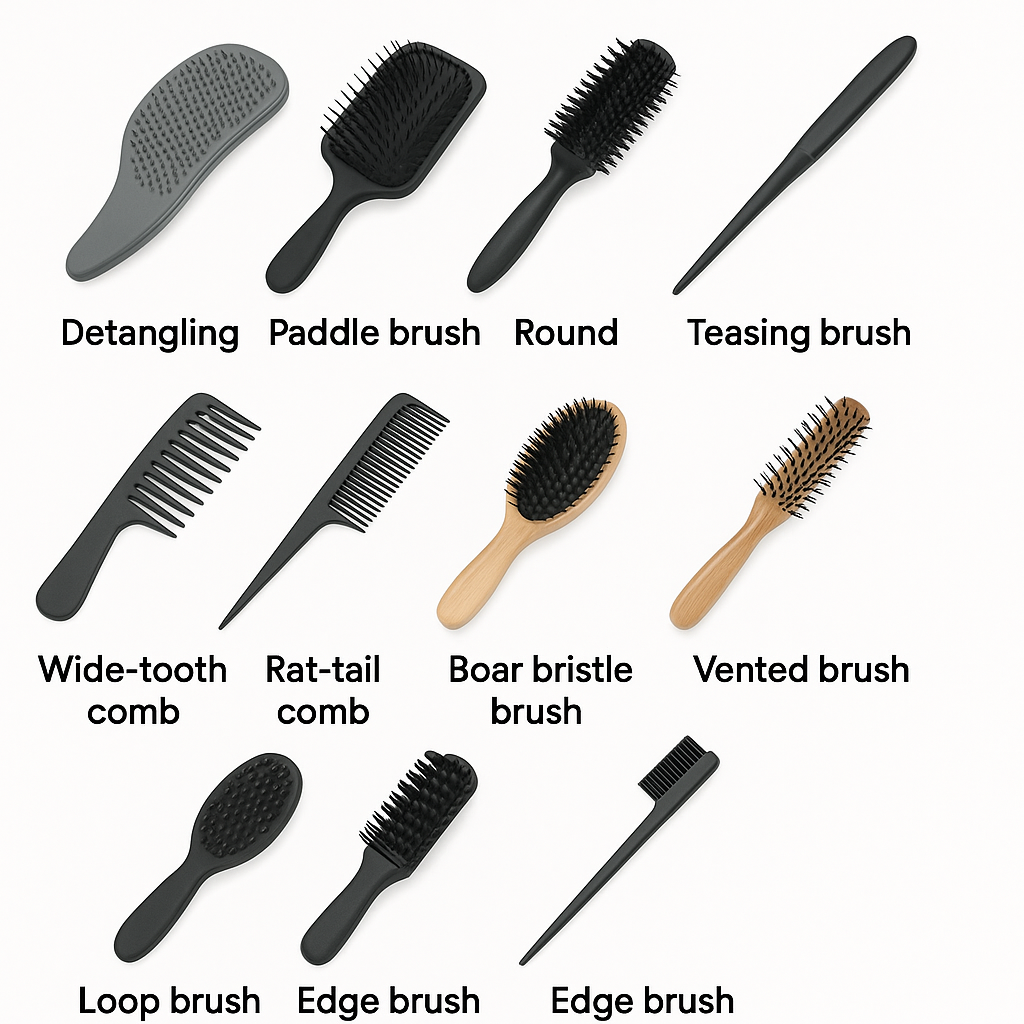Hair loss, hair breakage, or patchy hair growth—your patients might attribute these to stress or nutrition, but their hairbrush may be the hidden culprit.
Dermatologists often assess scalp conditions, hormonal factors, and medications when diagnosing hair issues. However, the type of hairbrush a patient uses can play a critical and often overlooked role in hair health. A recent review titled “Hairbrushes: A Guideline for Dermatologists” (Skin Appendage Disorders) dives into how incorrect brush types or poor brushing techniques may lead to trichomalacia, trichorrhexis nodosa, and traction alopecia.
In this article, we break down:
✅ What brush types to recommend or avoid
✅ The link between hairbrushes and hair damage
✅ How to tailor brush advice based on hair type
✅ Real clinical cases of brush-induced hair loss
🔎 Why Dermatologists Should Care About Hairbrush Selection
Hairbrushes have been around since 8000 B.C., yet there are no standardized guidelines for dermatologists when advising patients about them. Meanwhile, the global hairbrush market exceeded $4 billion in 2022, offering countless varieties—from boar bristle brushes to vented blow-dry brushes.
But not all brushes are created equal—and some may directly contribute to hair damage if misused.
Common Hairbrush Types and Their Risks
Here’s a dermatologist-approved breakdown of 10 types of hairbrushes and their relationship to hair loss, breakage, and scalp health:
1. Detangling Brush
- ✔ Best for: Gently untangling wet hair
- ⚠️ Risk: Trichomalacia if used aggressively on wet hair
- 💡 Tip: Use from the tips upward, gently and with conditioner
2. Paddle Brush
- ✔ Best for: Straight or wavy hair
- ⚠️ Risk: Hair breakage if used dry on curly hair
- 💡 Tip: Use with conditioner on curly hair and never yank
3. Round Brush
- ✔ Best for: Styling during blow-drying
- ⚠️ Risk: Improper size can cause snagging and breakage
- 💡 Tip: Use a smaller barrel for short hair, larger for long
4. Teasing Brush
- ✔ Best for: Creating volume
- ⚠️ Risk: Trichorrhexis nodosa from backcombing
- 💡 Tip: Use sparingly and avoid on already fragile hair
5. Wide-Tooth Comb
- ✔ Best for: Thick, curly, or textured hair
- ⚠️ Risk: Breakage if used forcefully on dry curly hair
- 💡 Tip: Always use with conditioner on wet curly hair
6. Rat-Tail Comb
- ✔ Best for: Parting, sectioning, and styling
- ⚠️ Risk: Minimal, but overuse may stress follicles during tight styles
7. Boar Bristle Brush
- ✔ Best for: Distributing scalp oils in straight or fine hair
- ⚠️ Risk: Frizz in curly/coily hair; bacteria buildup if not cleaned
- 💡 Tip: Avoid for curly hair and clean regularly
8. Vented Brush
- ✔ Best for: Blow-drying all hair types
- ⚠️ Risk: Hair breakage if used harshly on wet hair
- 💡 Tip: Use with a heat protectant spray
9. Loop Brush
- ✔ Best for: Hair extensions, thinning hair, sensitive scalps
- ⚠️ Risk: Not effective for thick/coarse hair
- 💡 Tip: Ideal for post-surgical or post-chemo patients with fragile hair
10. Edge Brush
- ✔ Best for: Styling baby hairs and edges
- ⚠️ Risk: Traction alopecia from over-styling
- 💡 Tip: Recommend soft bristles and limit daily use

Real-World Case: Detangling Brush & Trichomalacia
A 2023 study in JAMA Dermatology reported three patients who developed acquired diffuse trichomalacia after using detangling brushes for six months.
They presented to the National Skin Centre in Singapore, showing hair shaft distortion and patchy hair loss. Upon stopping use of the brushes, their condition gradually improved.
🧬 Key mechanism: Repeated brushing introduced uneven mechanical stress, disrupting keratin deposition and causing follicle matrix distortion.
What Dermatologists Can Do
👨⚕️ As part of your hair loss workup, add a question about brush habits:
“What kind of hairbrush do you use, and how often?”
Then advise based on their hair type and styling practices. Use this quick reference:
Hair Type | Best Brush Type | Avoid |
Fine/Straight | Boar Bristle, Paddle, Vented | Teasing, Edge (excessive use) |
Wavy | Paddle, Round | Detangling on dry hair |
Curly/Coily | Wide-Tooth Comb, Detangler | Boar Bristle, Paddle (dry use) |
Thinning/Sensitive | Loop Brush | Teasing, Edge, Rough Detanglers |
Extensions | Loop, Wide-Tooth | Round, Paddle |
Final Thoughts: Brush Smart, Not Hard
When it comes to hair loss, hair breakage, or poor hair growth, patients are quick to try supplements or topical treatments. But the solution might just be in their hands every morning—a brush.
Understanding how hairbrush types impact different hair textures can improve outcomes, reduce iatrogenic hair damage, and even prevent misdiagnoses of scarring alopecia or diffuse shedding.
References:
- Hairbrushes: A Guideline for Dermatologists. Skin Appendage Disorders, 2022
- Acquired Diffuse Trichomalacia With Detangling Hairbrush Use: A Case Series. JAMA Dermatol. 2023